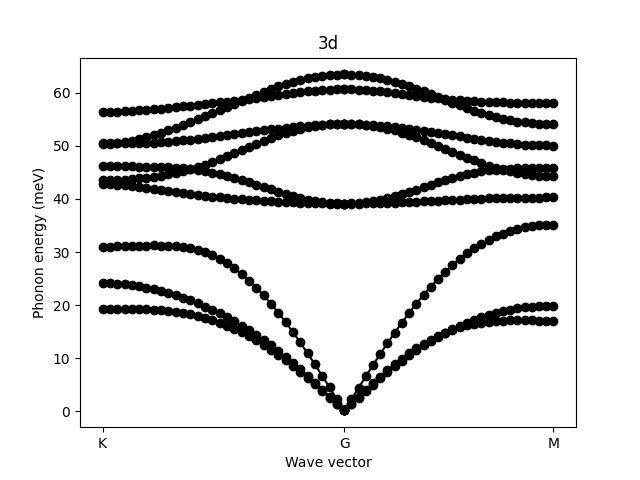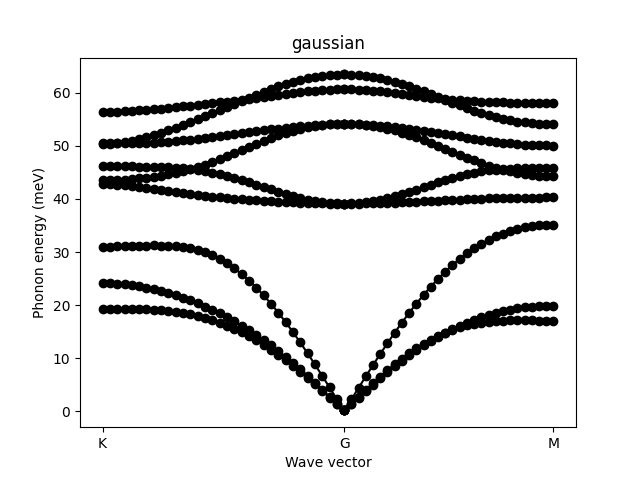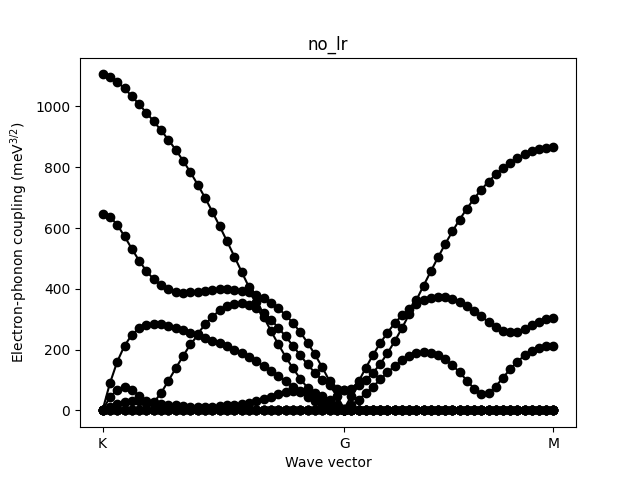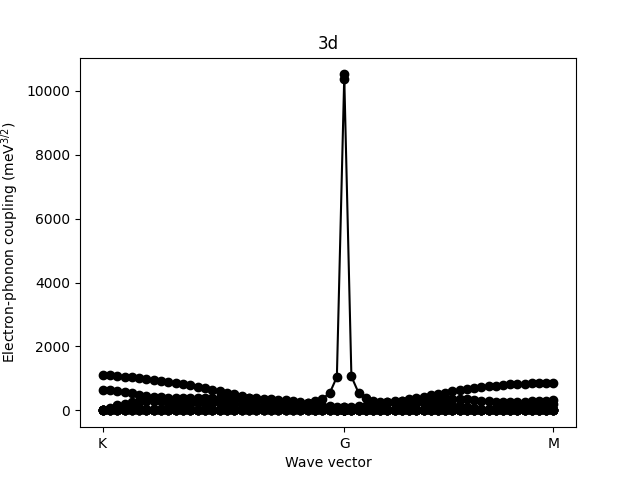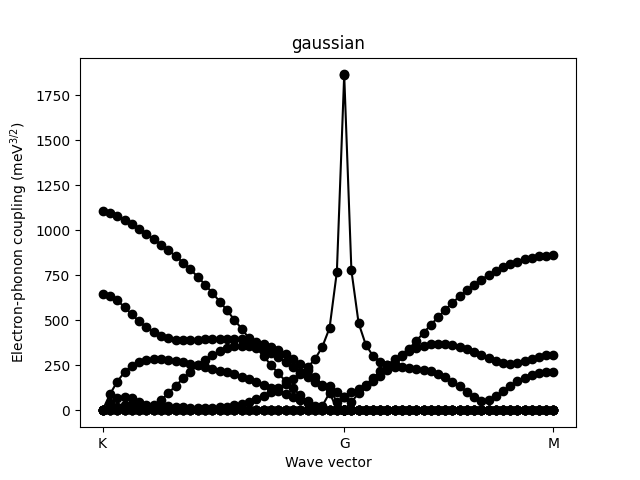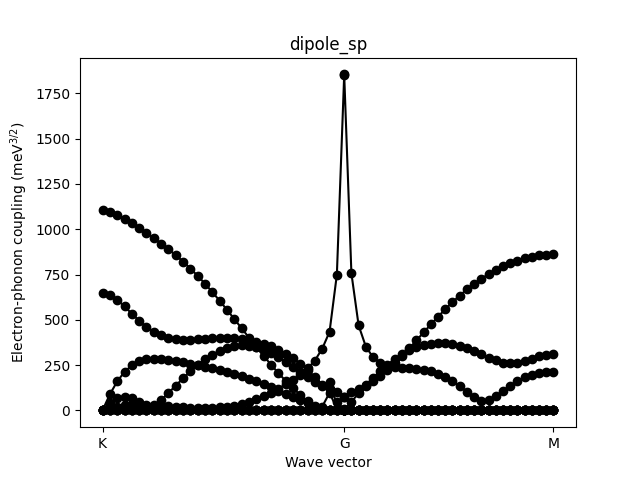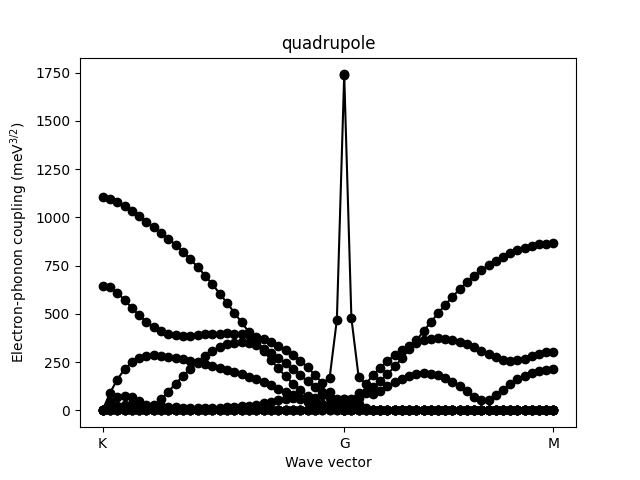Long-range terms
This example verifies that PHonon, EPW, and elphmod yield identical long-range terms for phonons and coupling.
The values of the quadrupole tensors originate from Poncé, Royo, Gibertini, Marzari, and Stengel, Accurate prediction of Hall mobilities in two-dimensional materials through gauge-covariant quadrupolar contributions Phys. Rev. Lett. 130, 166301 (2023).
#!/usr/bin/env python3
# Copyright (C) 2017-2025 elphmod Developers
# This program is free software under the terms of the GNU GPLv3 or later.
import elphmod
import matplotlib.pyplot as plt
import numpy as np
import sys
comm = elphmod.MPI.comm
path = 'KGM'
q, x, corners = elphmod.bravais.path(path, ibrav=4, N=50, moveG=0.1)
if len(sys.argv) > 1 and sys.argv[1] == '--prepare-q':
if comm.rank == 0:
q /= 2 * np.pi
weight = 1 / len(q)
with open('q.dat', 'w') as filqf:
filqf.write('%d crystal\n' % len(q))
for q1, q2, q3 in q:
filqf.write('%12.10f %12.10f %12.10f %12.10f\n'
% (q1, q2, q3, weight))
for lr in '3d', 'gaussian':
elphmod.bravais.write_matdyn('matdyn_%s.in' % lr, dict(
flfrc='%s.ifc' % lr,
flfrq='%s.freq' % lr,
nq=len(q),
q=q,
q_in_cryst_coord=True,
asr='simple',
loto_2d=lr != '3d',
fldos=' ',
fleig=' ',
flvec=' ',
))
raise SystemExit
number = iter(range(1, 99))
for lr in '3d', 'gaussian':
ph = elphmod.ph.Model('%s.ifc' % lr, apply_asr_simple=True, apply_zasr=True,
lr2d=lr != '3d', lr=True)
if '3d' in lr:
ph.prepare_long_range(G_2d=True)
w = elphmod.ph.sgnsqrt(elphmod.dispersion.dispersion(ph.D, q))
q0, x0, w0 = elphmod.el.read_bands('%s.freq' % lr)
if comm.rank == 0:
plt.plot(x, w0.T * 1e3 * elphmod.misc.cmm1, 'ok')
plt.plot(x, w * 1e3 * elphmod.misc.Ry, '-k')
plt.title(lr)
plt.ylabel('Phonon energy (meV)')
plt.xlabel('Wave vector')
plt.xticks(x[corners], path)
plt.savefig('lr_%d.png' % next(number))
plt.show()
el = elphmod.el.Model('MoS2')
for lr in 'no_lr', '3d', 'gaussian', 'dipole_sp', 'quadrupole':
ph = elphmod.ph.Model('dyn', apply_asr_simple=True, apply_zasr=True,
lr=lr != 'no_lr',
lr2d=lr != '3d',
L=elphmod.elph.read_L('epw_%s.out' % lr),
quadrupole_fmt='_quadrupole.fmt' if lr == 'quadrupole' else None)
if '3d' in lr:
ph.prepare_long_range(G_2d=True)
elph = elphmod.elph.Model('%s.epmatwp' % lr, 'wigner.fmt', el, ph)
g = np.absolute([elph.g(q1, q2, q3, elbnd=True, phbnd=True)
for q1, q2, q3 in q])
g = np.sort(g, axis=1)
w0, g0 = elphmod.elph.read_prtgkk('epw_%s.out' % lr,
nq=len(q), nmodes=ph.size, nk=1, nbnd=el.size)
if comm.rank == 0:
plt.plot(x, elphmod.ph.sgnsqrt(2 * w0) * g0[:, :, 0, 0, 0], 'ok')
plt.plot(x, g[:, :, 0, 0] * (1e3 * elphmod.misc.Ry) ** 1.5, '-k')
plt.title(lr)
plt.ylabel('Electron-phonon coupling (meV$^{3 / 2}$)')
plt.xlabel('Wave vector')
plt.xticks(x[corners], path)
plt.savefig('lr_%d.png' % next(number))
plt.show()
